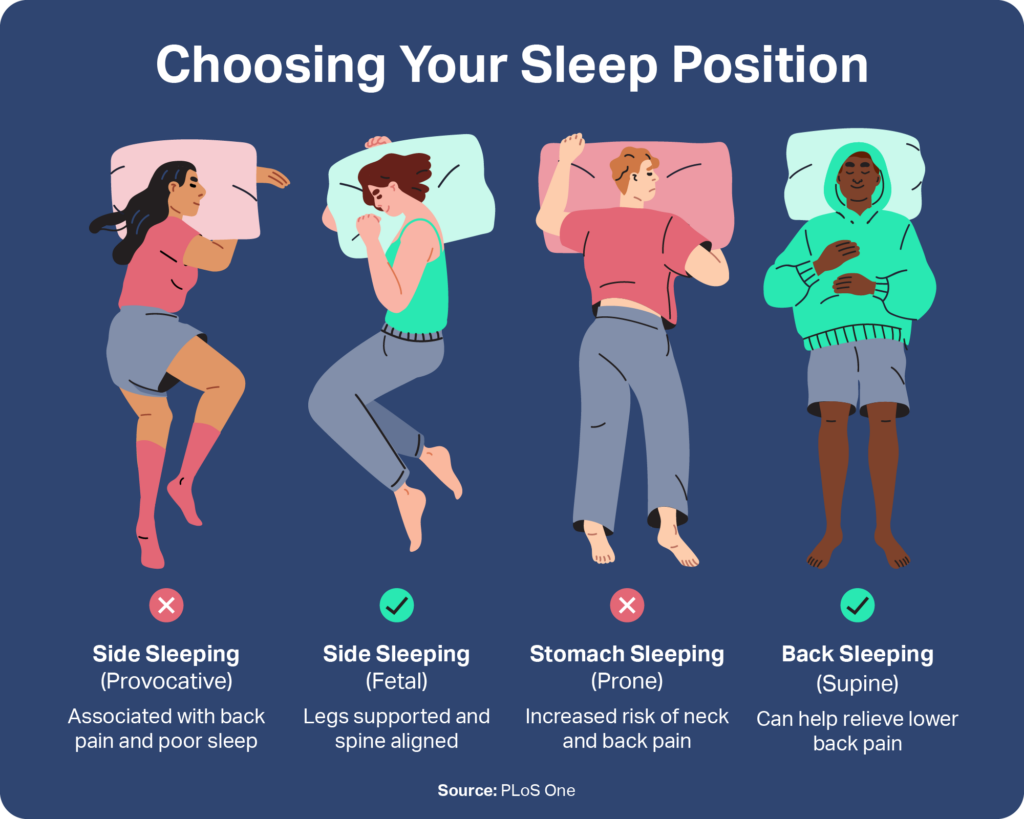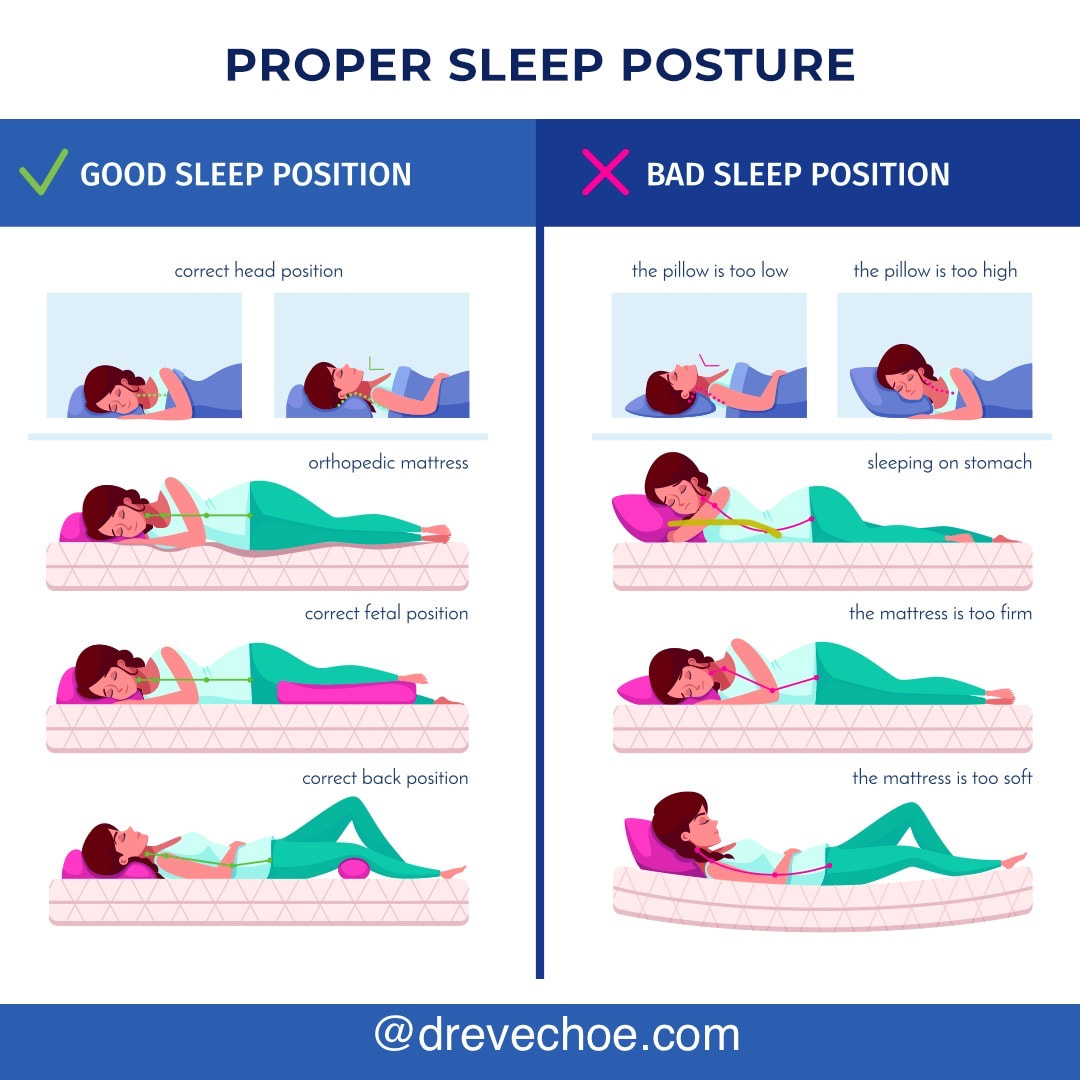How to Correct Body Posture While Sleeping
Correcting body posture while sleeping is essential for good health. Proper alignment can prevent pain and improve sleep quality.
Many people wake up feeling sore or stiff. This often results from poor sleeping posture. Our bodies need support to rest and heal during the night. Bad posture can lead to chronic issues over time. It is crucial to find the right sleeping position and maintain it.
This guide will help you understand how to correct your body posture while sleeping. It covers tips and techniques to ensure your body stays aligned. By following these steps, you can wake up feeling refreshed and pain-free. Let’s explore how to make your sleep posture healthier and more comfortable.

Credit: www.sleepfoundation.org
Importance Of Good Sleep Posture
Good sleep posture helps prevent back and neck pain. It keeps the spine in a healthy position. A proper posture can improve blood circulation. It reduces stress on muscles and joints. You may wake up feeling more refreshed. This helps you stay active during the day.
Correct posture can improve sleep quality. You may fall asleep faster. Fewer interruptions during the night. It helps in achieving deep sleep. Deep sleep is crucial for body repair. This leads to overall better health.

Credit: integrativephysicalhealth.com
Common Sleep Posture Mistakes
Sleeping on your stomach may feel comfortable, but it can hurt your back. This position can twist your neck. Also, it flattens the curve of your spine. It is better to sleep on your back or side. They keep your spine in a better position. Using a thin pillow can help if you must sleep on your stomach.
Too many pillows can strain your neck. One pillow under your head is usually enough. A second pillow can go under your knees if you sleep on your back. This can help your spine stay aligned. When sleeping on your side, hug a pillow. This helps keep your spine straight. Keep it simple for better sleep.
Best Sleeping Positions
Sleeping on your back is good for your spine. It keeps your head, neck, and spine in a neutral position. Use a pillow under your knees. This helps to keep the natural curve of your lower back. A small pillow under your lower back can also help. Avoid using too many pillows under your head. This can strain your neck. A thin, supportive pillow is best for your head.
Side sleeping is another good option. It reduces snoring and helps with sleep apnea. Use a pillow between your knees. This keeps your hips, pelvis, and spine in better alignment. A firm pillow under your head is important. It supports your neck and keeps your spine straight. Avoid curling up too tightly. This can lead to back and neck pain. A body pillow can help you stay comfortable.
Choosing The Right Mattress
Mattress firmness is key for good sleep. A medium-firm mattress supports the body well. Too soft, and it can hurt your back. Too hard, and it can cause discomfort. Firmness should suit your sleeping position. Side sleepers need a softer mattress. Back sleepers need a firmer one. Test the mattress before buying.
Memory foam mattresses mold to your body shape. They offer good support. Innerspring mattresses have coils inside. They are firm and bouncy. Latex mattresses are durable and firm. Hybrid mattresses mix foam and coils. They offer the best of both worlds. Choose the material that feels most comfortable.
Selecting Suitable Pillows
Pillow height is very important. It affects your neck and spine. Choose a pillow that keeps your neck straight. Too high or too low can cause pain. Test different heights. Find the most comfortable one. It should fit your sleeping position. Side sleepers need higher pillows. Back sleepers need medium height. Stomach sleepers need low pillows.
Pillow material affects comfort and support. Memory foam pillows are popular. They mold to your head and neck. Feather pillows are soft but may not give enough support. Latex pillows are firm and supportive. They are good for people with allergies. Choose a material that feels good to you. It should support your head and neck well. Try different materials. Find the best one for your needs.

Credit: www.wikihow.com
Creating A Sleep-friendly Environment
Set up your bedroom to be calm and quiet. Remove any distractions, like bright lights or loud noises. Your bed should be comfortable and supportive.
Keep your room cool. A temperature between 60-67°F is best. Use a fan or open a window if needed. Avoid heavy blankets if you get too warm. Light blankets are better.
Stretching And Exercises
Start your day with gentle morning stretches. Try reaching up to the sky. Bend slowly and touch your toes. Hold each stretch for 10 seconds. This will loosen muscles and improve posture. Repeat each stretch three times. Avoid quick, jerky movements.
Perform a few stretches before bed. Lie on your back and pull one knee to your chest. Switch legs and repeat. Stretch your arms above your head. Relax and breathe deeply. This prepares your body for better sleep posture. Consistent routines will help improve sleep posture over time.
Using Sleep Aids
Orthopedic pillows help keep your neck and spine aligned. They are designed to support the natural curve of your neck. These pillows can reduce pain and improve sleep quality. It is important to choose a pillow that fits your sleeping position. Side sleepers need a different pillow than back sleepers. Orthopedic pillows can be firm or soft. Choose one that feels comfortable for you.
Supportive cushions can help with body alignment. They provide extra support for your lower back, hips, or knees. Using these cushions can reduce pressure on your joints. They can help you maintain a good posture while sleeping. Different types of cushions are available for different needs. Find the one that best suits you.
Frequently Asked Questions
What Is The Best Sleeping Position For Posture?
The best sleeping position for posture is on your back. It helps keep your spine aligned. Using a supportive pillow under your neck can enhance comfort and alignment.
How Does A Bad Mattress Affect Posture?
A bad mattress can negatively affect your posture. It may cause back pain and misalignment. Choose a firm mattress to support your spine properly.
Can Sleeping On Your Stomach Hurt Your Posture?
Yes, sleeping on your stomach can hurt your posture. It strains your neck and spine. It’s best to avoid this position for better alignment.
How Can Pillows Improve Sleeping Posture?
Pillows can improve sleeping posture by providing support. Use one under your neck and knees. This helps maintain spine alignment and reduces strain.
Conclusion
Proper sleep posture is key for a healthy body. Prioritize comfort and alignment. Use supportive pillows and a good mattress. Avoid sleeping on your stomach. Experiment to find what works best for you. Good posture can reduce pain and improve sleep quality.
Small changes can make a big difference. Start tonight and notice the benefits. Sleep well and wake up refreshed. Your body will thank you.


